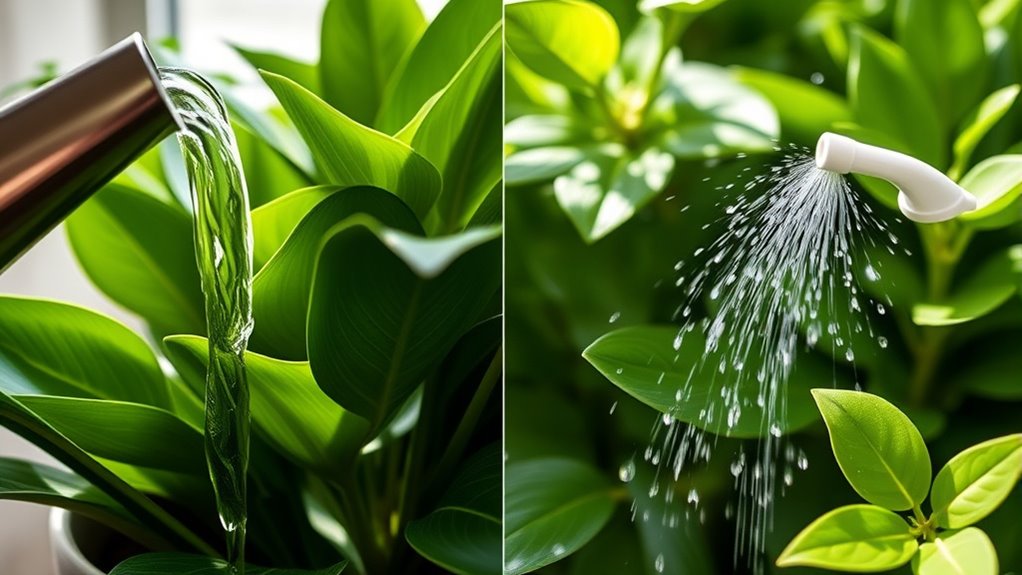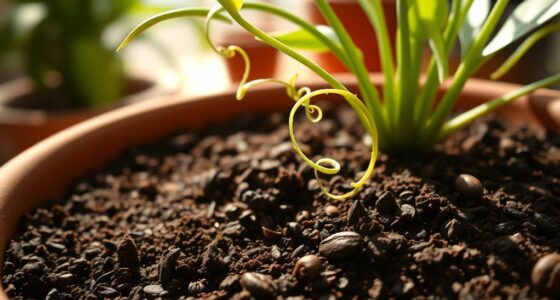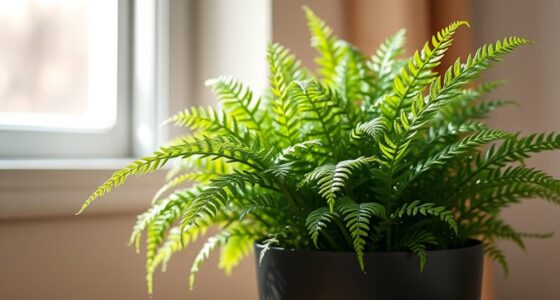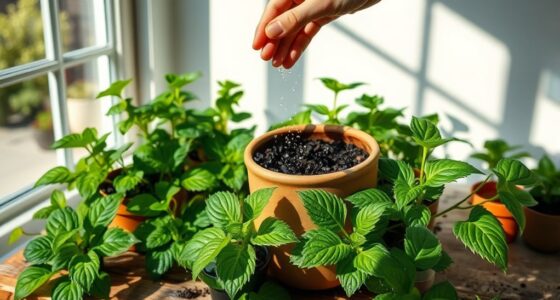Deep watering involves soaking your indoor plants thoroughly so the moisture reaches deep into the soil, promoting strong root growth and reducing watering frequency. In contrast, frequent sprinkles keep the surface moist but don’t reach the roots deep, which can stress your plants and make them more drought-prone. Understanding when to use each method can help you keep your plants healthier during summer. Keep exploring to find the best watering strategy for your indoor green space.
Key Takeaways
- Deep watering encourages roots to grow deeper, improving drought resilience, while frequent sprinkles keep the surface moist but may weaken root depth.
- Deep watering reduces watering frequency and prevents surface fungal issues, unlike frequent sprinkles, which can cause inconsistent soil moisture.
- During summer, deep watering helps maintain stable soil moisture and reduces plant stress more effectively than light, frequent watering.
- Adjust watering practices based on pot size and environment; larger pots benefit from deep watering, while smaller ones may need more frequent, lighter watering.
- Consistent soil moisture from deep watering supports healthier, more resilient indoor plants during hot, dry summer conditions.

When it comes to watering your plants, understanding the difference between deep watering and frequent sprinkles can make a big impact on their health. The key lies in how you manage soil moisture and determine the right watering frequency. Deep watering involves thoroughly soaking the soil so moisture penetrates several inches down, encouraging roots to grow deeper and stronger. This method creates a more stable environment for your indoor plants, especially during the summer when evaporation rates are high. In contrast, frequent sprinkles involve light, shallow watering sessions that keep the surface moist but don’t reach the deeper roots. While this might seem beneficial, it often leads to inconsistent soil moisture levels and weak root systems.
When you focus on deep watering, you give your plants a more reliable and consistent supply of moisture. This approach reduces the need for constant watering, which can cause overwatering or waterlogged soil. It also promotes better soil structure, allowing roots to access water from deeper layers instead of just the surface. As a result, your plants become more resilient to drought stress and fluctuations in indoor humidity. The best way to achieve this is by watering slowly and thoroughly until you see excess water drain from the pot’s drainage holes. This ensures the entire root zone receives adequate hydration. Remember, the watering frequency should be based on your plant’s specific needs, pot size, and the environment. For instance, larger pots or plants in drier rooms may require watering less frequently but more deeply, while smaller pots may need regular, moderate watering.
Frequent sprinkles, on the other hand, can lead to a cycle of partial drying and re-wetting that stresses the roots. Shallow watering doesn’t promote deep root growth, which makes your plants more vulnerable to drought conditions. It also increases the risk of fungal infections or rot since the soil remains consistently moist at the surface but may stay too dry at deeper levels. If you prefer to water this way, be mindful of the soil moisture level by checking the top inch regularly. You want to avoid letting the soil stay soggy or completely dry before watering again. This method might seem easier, but it often results in uneven watering habits and weaker plants over time.
Additionally, understanding the importance of contrast ratio can help you optimize your watering strategy by ensuring your indoor environment supports healthy plant growth. Ultimately, mastering the balance between soil moisture and watering frequency is essential. Deep watering fosters healthy, resilient roots, reducing the overall effort needed to care for your indoor plants in summer. By understanding when and how much to water, you’ll create a thriving environment that keeps your plants happy and healthy all season long.
Frequently Asked Questions
How Do I Identify Overwatering Signs in Indoor Plants?
You can spot overwatering in your indoor plants by checking for signs like yellowing leaves, wilting, or a sour smell. Poor soil aeration often leads to soggy soil, which increases the risk of root rot. To prevent this, make sure your plant’s pot has drainage holes and avoid watering too frequently. If roots look brown or mushy, it’s a clear sign you’re overwatering and need to adjust your watering habits.
Can Different Plant Species Require Different Watering Approaches?
You should recognize that different plant species have unique hydration needs, so plant-specific watering approaches are essential. Some plants thrive with deep, infrequent watering, while others prefer lighter, more frequent sprinkles. By understanding your plant’s specific watering requirements, you guarantee healthy growth and avoid overwatering or underwatering. Always research each species’ hydration needs to tailor your watering strategy effectively, keeping your indoor plants happy and thriving.
What Tools Are Best for Measuring Soil Moisture Accurately?
To measure soil moisture accurately, you should use tools like moisture meters and soil probes. Moisture meters give quick readings, showing whether your plants need water. Soil probes allow you to check moisture levels at different depths, ensuring you don’t over or underwater. By regularly using these tools, you can maintain proper watering habits, keeping your indoor plants healthy, especially during hot summer months.
How Does Indoor Humidity Affect Watering Needs?
Did you know that indoor humidity levels can vary by up to 50%? Higher humidity reduces transpiration rates, meaning your plants lose less water through their leaves. When humidity is high, you may need less frequent watering, as the moisture in the air helps sustain them. Conversely, in dry environments, plants transpire more and require more frequent watering to stay healthy. Keep an eye on humidity to adjust your watering schedule accordingly.
Should Watering Frequency Change During Indoor Heating in Summer?
You should adjust your watering schedule during indoor heating in summer to guarantee proper plant hydration. Heating can dry out the air and soil faster, so you might need to water more frequently. Keep an eye on your plants’ soil moisture and avoid overwatering. By monitoring and adapting, you help your plants stay healthy and hydrated despite the dry indoor environment caused by summer heating.
Conclusion
So, whether you choose deep watering or frequent sprinkles, remember that your indoor plants rely on your attention and care. Think of your watering strategy as a dance—you lead with confidence, knowing each move keeps your plants thriving. By understanding their needs and adjusting your approach, you’ll turn your space into a lush oasis. After all, isn’t nurturing your green friends the most rewarding rhythm of all? Keep watering wisely, and watch your indoor garden flourish.











